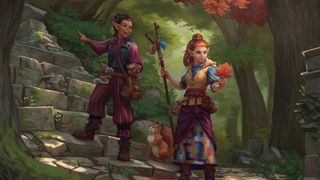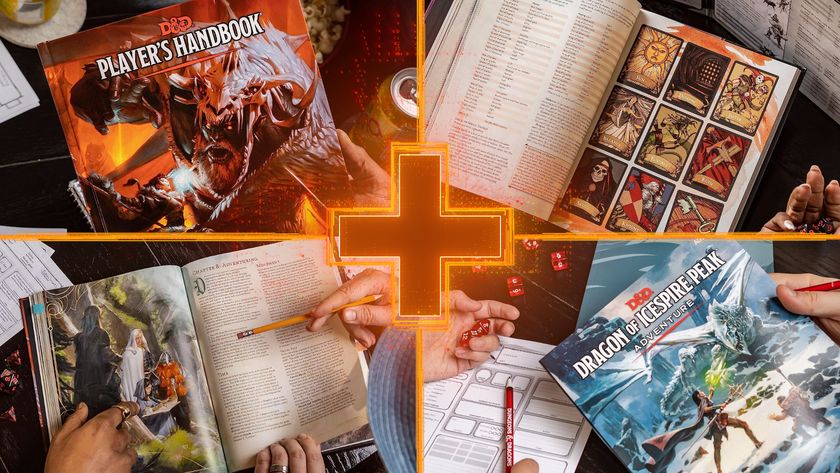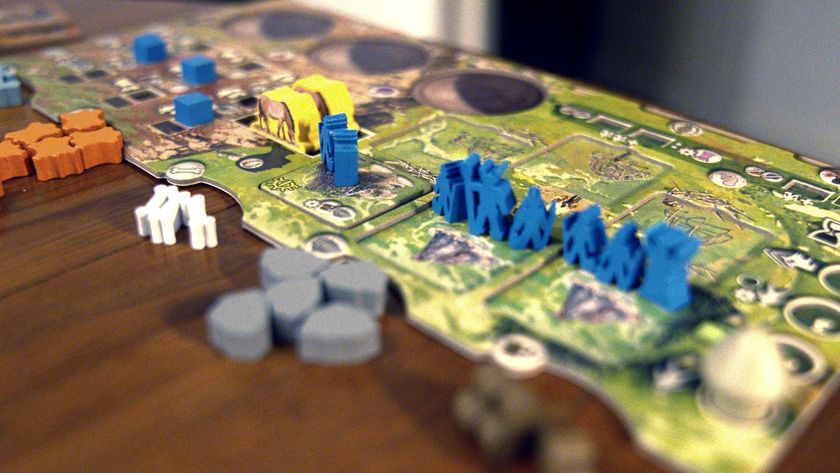12DOVE Verdict
This classic setting has been MIA for too long, and Dragonlance: Shadow of the Dragon Queen is a worthy comeback. As well as sidestepping most issues that Dragonlance adventures suffered from in the past, it offers a sense of scale not present in many D&D stories - this conflict is much bigger than you. Crucially, the wartime backdrop isn't a theme we've seen from D&D's current edition either. That makes it a refreshing change of pace.
Pros
- +
Brings back a classic role-playing setting with style and lots of variety
- +
Martial focus makes for a very unusual campaign structure and feel
- +
New mechanical aspects are fun and well-integrated into the campaign
Cons
- -
Early portions are poor, with excessive railroading
Why you can trust 12DOVE
Dragonlance is one of the most iconic sub-brands associated with Dungeons & Dragons. It started as an epic, high fantasy, dragon-filled campaign for Advanced D&D (or 'AD&D'), heavy on both narrative and railroading, which involved the players in a war. And even though there have been various Dragonlance supplements for the editions since, adventure hardback Shadow of the Dragon Queen is the first one we’ve seen for the fifth edition, giving players and Dungeon Masters alike a chance to explore this famous world.
Was it worth the wait? For the most part, yes. While Dragonlance: Shadow of the Dragon Queen is by no means perfect, it succeeds in bringing a beloved setting back to the best tabletop RPGs.
Dragonlance: Shadow of the Dragon Queen - features
| Price | $49.95 / £42 |
| Ages | 14+ |
| Players | 2 - 6 |
| System | D&D (fifth edition) |
| Lasts | 2hrs per session |
| Complexity | Moderate |
| Play if you enjoy | Classic high fantasy, war stories, Dragonlance novels |
The main draw here is the return of Dragonlance, an iconic setting launched in the '80s, along with world-specific class options and races such as the infamous Kender (halfling replacements with a knack for mischief and winding up the enemy). It revolves around a continent-spanning war against the seemingly unstoppable Dragon Army.
As a totally new, standalone adventure, all you need in order to play Shadow of the Dragon Queen are the basic rules (or the Player's Handbook) and the Monster Manual for certain enemy stats. Like other story-driven Dungeons and Dragons books, it also encourages players to roll with new heroes; its quests are designed to take characters from level 1 to 11.
How does it work?

- New race to play (the 'Fearless' Kender)
- Two new backgrounds and a Sorcerer subclass
- First-level 'prelude' encounters to be run solo
Shadow of the Dragon Queen, like all Dragonlance material, is set in the classic fantasy world of Krynn which may not be familiar to newer gamers, so the initial chapter of the book does some scene-setting. There’s a quick world overview with a focus on Solamnia, the nation where most of this adventure takes place. It then dives into Krynn-specific class options (like a new subclass for Sorcerers who draw their magic from Krynn’s moons), the species you can play as along with how they differ to classic D&D lore, and backstory detail.
This is where rules for the Kender come in, offering a lowdown on what makes them special - namely, a 'Fearless' feature that lets you overcome the 'frightened' condition, and the opportunity to taunt foes so that they have disadvantage on attack rolls against targets other than you.
This is a tough module, so characters start with a free feat
Mechanically speaking, most noteworthy are the two new backgrounds that tie into the setting, the Knight of Solamnia and Mage of High Sorcery. This is a tough module, so characters start with a free feat including a selection that dovetails nicely with the new backgrounds.
One other noteworthy aspect of life on Krynn is that, when the adventure starts, Clerics aren’t supposed to have access to any spells. This isn’t as well signposted as perhaps it should be. Player Clerics get their magic during one of the module's final innovations: preludes. These are very short encounters for first-level characters intended to be tackled by a lone player or a subgroup of the whole party prior to the campaign proper.
Gameplay

- Sense of epic scale thanks to being one part of a larger conflict
- Can be supplemented with a board game, but doesn't need it
- Feels authentically Dragonlance - warts and all
The original Dragonlance modules were infamous for expecting players to make certain decisions, even down to internal party dynamics with pre-generated characters. Shadow of the Dragon Queen isn’t, for the most part, anywhere near that bad. But the parts that are - the preludes and the initial chapter - both repeat many of the same mistakes as those old adventures, to the extent that it almost feels like a deliberate homage. They simply presume that the party will follow suggestions given by NPCs in the chapter, and take particular actions in response to events, and largely in order at that.
This initial phase closes with the first of many battle scenes which the module suggests you can play out in full using the accompanying board game, Warriors of Krynn. Some groups with strategic leanings will find this a welcome change of pace, while dedicated role-players will not. The good news is that narrative alternatives are provided for all the battles, and they’re all excellent. The idea is that the party-members are placed on a small boxed map within the larger battle in which they can move around and have a series of encounters that influence the wider conflict. They work well, and there’s no need to use the board game unless it appeals to your group.

If you want to expand on the clashes seen within this book, you can zoom out for a broader view of the conflict via Warriors of Krynn. Although it's able to function as a standalone experience, it's much better if you tie it into your Shadow of the Dragon Queen campaign - your success or failure in one influences the other. As I mentioned during my Dragonlance: Warriors of Krynn review, "the core concepts of a cooperative quest driven by an external battle mini-game work very well, providing plenty of challenges with an unusual thematic standpoint."
After this relatively weak start, the module improves tremendously as the players are swept up in an unfolding war. There’s still a degree of railroading as the party moves between locations, but a certain amount of it is almost inevitable in adventures of this kind. These further chapters tend to work by giving the players a base in the new location and letting them explore it freely, giving the DM a palette of events and NPCs to throw at the party when needed, or sometimes on a timed basis, to help keep things fresh. Rather than the open sandbox style of adventure that’s become so popular, it’s like a series of mini-sandboxes. They vary in style from military missions to dungeon delving to open-world exploration.
Where the module really stands out is the way it provides a sense of the players as part of a larger military campaign. Not only is this an adventure concept that’s not been touched before in fifth edition Dungeons & Dragons, but it makes a refreshing change from the way characters tend to be expected to rock up and save the world. In Shadow of the Dragon Queen, their actions are still pivotal in determining how things pan out, but it’s very clear they’re only part of much wider events unfolding across all of Krynn. It gives a real sense of epic scale that’s lacking even in previous, world-spanning adventures.
So far as mechanics go, most of the new additions in the module work very well
All these soldierly shenanigans give the adventure scope to vary the pace and size of combat encounters, and it grabs this opportunity with both hands. There are small-scale encounters and bigger boss fights that you’ll be familiar with from typical scenarios, in both dungeon and wilderness settings. But as part of military operations, the party will get caught up in everything from desperate rearguard actions to protect a retreat to actual siege warfare. There’s also a classic big bad from the initial Dragonlance campaign in the adventure that’s too powerful for the party to defeat, marking another change of pace and adding to the sense of wider events unfolding beyond their control.
So far as mechanics go, most of the new additions in the module work very well. There are some fun new foes to fight and cool new treasures to claim for defeating them. The class options are particularly good, from the lunar Sorcerer whose powers are tied to the moon phases, to the two backgrounds which offer excellent narrative and role-playing tie-ins to the adventure.
The one exception is the preludes. These seem like a nice idea in theory but in practice, it’s often difficult to split the group up for individual introductory adventures, and their writing and structure are weak.
Should you buy Dragonlance: Shadow of the Dragon Queen?

Shadow of the Dragon Queen boldly throws out a lot of the received wisdom about how modern campaigns should be designed… and mostly gets away with it. Although some groups will chafe against its slightly po-faced high fantasy tone and others against its restrictions, these are relatively few and the payoff - an unusual campaign structure in an evocative and well-realized setting - is worthwhile. It’s nice to see so much thought going into new rules that really help reinforce the unique nature of both the adventure and the world it’s set in.
It’s only a shame that it’s taken this long for Dragonlance to return to the fifth-edition fold.
Buy it if...
Taking part in an epic fantasy war appeals to you
Battling amongst clashing armies isn't something D&D's done much of in recent years, so Shadow of the Dragon Queen is perfect if you want a different sort of gameplay experience.
You love Dragonlance and/or classic high fantasy
This setting is one of the most beloved in all of D&D, so it'll be a delight for fans of the series - it's a fitting tribute.
Don't buy it if...
Slow starts frustrate you
Although you will be drawn into the war, Shadow of the Dragon Queen does take time to set that up.
You don't want to be locked into a long-term war
This adventure book is all about a continent-spanning conflict, so those who prefer classic adventuring may prefer to look elsewhere.
How we tested Dragonlance: Shadow of the Dragon Queen
As well as reading through the entirety of this book, I tested Shadow of the Dragon Queen in conjunction with the accompanying board game, Warriors of Krynn, to see how they complemented one another.
For more information on our process, see how we test products.
This copy of the game was provided by Asmodee.
For more recommendations, check out the best board games, essential board games for 2 players, and the top board games for families.
More info
| Genre | RPG |
Matt is a freelance writer specialising in board games and tabletop. With over a decade of reviews under his belt, he has racked up credits including IGN, Dicebreaker, T3, and The Guardian.



















Dino Crisis gets a fresh trademark filing by Capcom, but it might not mean the 26-year-old survival horror franchise will get a new installment like fans expect

Netflix is making a brand new adaptation of Cujo, the infamous Stephen King book about a killer dog

Veteran Dragon Age dev says one big delay is better than several small ones: "You are laying band-aid on top of band-aid on top of band-aid"





